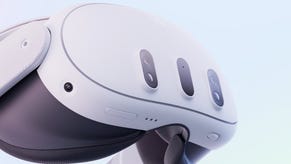GDC: Finding perceived value for peripherals
Mike Haigh, studio director of SCEE London, spoke to GDC attendees about the process involved in developing peripherals and their associated software applications
Mike Haigh, studio director of SCEE London, spoke to GDC attendees about the process involved in developing peripherals and their associated software applications.
Haigh, whose team has worked on SingStar, Buzz and EyeToy, focused on the development of the latter product - which has sold an estimated 9 million units worldwide.
"Development of a compelling experience is a little bit of a chicken and an egg," Haigh noted. "What came first? Hardware or software?
In the case of the EyeToy, both were inextricably intertwined.
The PlayStation camera peripheral was the brainchild of Dr. Richard Marks who had studied robotics at Stanford before seeing the PS2 unveiled in 1999.
Using a video camera and a special PS2 debug unit, Marks started tinkering with video and filters, eventually developing what came to be called the "spider" demo.
The demo, which involved computer-generated "spiders" attaching themselves to and moving with an on-camera subject, became one of his favourites because, as Haigh explained, "So often inspirational stuff is done completely by accident."
Marks had actually been trying to generate a 3D head and was using asterisks — which looked like spiders - as positional markers.
"The technology that started off as filters led to all sorts of experiments and ideas," Haigh explained.
Marks approached numerous video camera manufacturers who were all quite hesitant to help — especially since Sony was known for making its own cameras, and these manufacturers may have thought the company could take their designs.
Eventually, a company called OmniVision saw the potential market for the product and was willing to take the risk.
Haigh detailed the patents filed by both Dr. Marks and OmniVision in an attempt to protect their IP and keep their competitive advantage.
"Just because a patent is granted, may not mean it is enforceable when it is challenged," he explained.
Once Sony had something it could work with, it had to make the business case for the project — not knowing how much it was going to cost, but knowing where they wanted it to be.
On a scale of perceived user value and cost, the higher the value to the consumer, the more money they will be willing to pay for it.
"People are prepared to pay [for Rock Band] because it has a high user value," Haigh provided as an example.
"We didn't want people to be paying for a camera per se. We wanted them to pay for the experience — the camera came with it."
After putting together three specific EyeToy games for marketing purposes, the company started demonstrating the technology.
"We got complete buy-in from every one we approached. It was something that hadn't been done before. It was an ambitious step, if you like."
Sony ended up using two different sources for manufacturing the product in order to ramp up production quickly. It designed the camera to resemble the PS2 hardware in order to make people feel that they were buying into "a true PlayStation peripheral — part of the family," according to Haigh.
In this day and age of Rock Band guitars and SingStar microphones, it is easy to forget that before EyeToy was released in 2003, peripherals weren't known for selling.
"We were only thinking about making 25 to 30,000 units tops," said Haigh, to see if it was successful or not, in which case they might produce 50,000.
Haigh recalls a marketing meeting in which David Reeves suggested that, rather than 50,000, why not aim for 500,000? Chris Deering — noting that the company had taken bigger risks before — instead suggested that they make a million.
And so, in one meeting, EyeToy production went from 25,000 to 1 million. Fortunately for SCEE, in the first 6 months it went on to sell 5 million.
Shipping the manufactured cameras from China to Europe took nearly a month, which meant that the company wouldn't be able to quickly respond to changes in demand.
Since EyeToy's release in 2003, there have been 11 subcontractors involved with over 335 million components. Over 4.1 million blister packs of PS2 peripherals and software were released in PAL territories in 2007.
The entire process is incredibly labour intensive, according to Haigh.
"If you have a successful peripheral, there's so much more to it that you possibly imagined," he admitted.


.jpg?width=291&height=164&fit=crop&quality=80&format=jpg&auto=webp)




